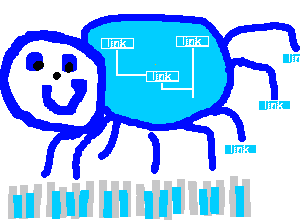New
Criticism
Psychoanalysis
Feminism
Reader
Response
Structurism
& Semiotics
Marxism
Postmodernism
Nation
& Postcolonialism
Cultural
Studies
解構主義
 |
|
| Literary
Criticism Databank
New
Criticism
|
解構主義
Under Construction
|
I.
Major Concepts of Poststructuralism: ![]() Some
Post-Structural Assumptions (remote)
Some
Post-Structural Assumptions (remote)
1. The play of
signifiers: (It moves, it multiplies, it is material and exchangeable.)
The stable connection/unity
of signifier and signified is challenged. More emphasis is put on
the signifier, and its play. ![]() critique
of meaning
critique
of meaning
2. Anti-Humanism ![]() critique
of human subject
critique
of human subject
The notion of the
subject as a unity of consciousness and agent has been challenged.
e.g.
4. Self-Reflexivity & Concerns with Representation : Theory and practice are no longer separable. Theories become more self-reflexive.
![]() Major
Theorists:
Major
Theorists:
Early influences:Mikhail Bahktin(Difference between Bahktin and Barthes in their view of referentiality)
Bahktin: The relation between art and reality is defined by chronotope. Chronotope is the process of assimilating real time and space; it is the historical time and space artistically shaped and expressed in art.
Barthes: In the most realistic novel, the referent has no "reality." What we called "real" is never more than a code of representation: it is never a code of execution: the novelistic real is not operable.
Barthes and Foucault (An Outline by Allison Lin)
A. deconstruct traditional texts
1. reverse the binary hierarchy (finding its supplementation)'textbook
81-82
e.g. "Young Goodman Brown"; "Prufrock" Paradise Lost
2. find out a text's gap, or critical difference (contradictions in a text),
and indeterminacy
e. g. Wordsworth's "Afterthought" and "A Slumber did my Spirit Seal",
Huckleberry Finn, Billy Budd
indeterminacy: Scarlet Letter, "Purloined Letter"
3. the textual unconscious (ideology)
"Eveline" ; "Fire Sermon" from The Waste Land
B. explain intertextuality in postmodern texts
C. discuss Derrida's ideas as they are illustrated in a text: "Deconstructing Jeffefries." ("Snowed Up")